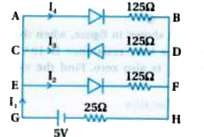The number density of electron is a semiconductor is 8×1013cm−3 and number density of hole is 5×1012cm−3 then,
(1) Which type of this semiconductor is?
(2) How much is resistivity of it? (Mobility of electron is 23000 cm2V−1s−1 and mobility of hole is 100 cm2V−1s−1ande=1.6×10−19C) Solution in Gujrati
p−29.45×10−2Ωm
n−3.396×10−2Ωm
p−3.396×10−2Ωm
n−2.945×10−2Ωm
The correct Answer is:B
n−3.396×10−2Ωm
ne=8×1013cm−3=8×1019m−3
nh=5×1012cm−3=5×1018m−3
μe=23000cm2V−1s1=2.3m2V−1s−1
μh=100cm2V−1s−1=0.01m2V−1s−1
Here, the number of electrons is higher than the holes so semiconductor will be n-type semiconductor (ne>nh)
σ=1ρ=e(μeμe+nhμh)=1.6×10−19
[8×1019×2.3×5×1018×0.01]
=1.6×10−19[1.84×1020+5×1016]
1ρ≈29.45mho m−1
∴ρ=129.45=3.396×10−2ohm m
∴ρ=3.396×10−2Ωm
Topper's Solved these Questions
- BOOK - KUMAR PRAKASHANCHAPTER - SEMICONDUCTOR ELECTRONICS : MATERIALS, DEVICES AND SIMPLE CIRCUITS EXERCISE - Section-D : Multiple Choice Questions (MCQs) (MCQs asked in Competitive Exams)129videos
SEMICONDUCTOR ELECTRONICS : MATERIALS, DEVICES AND SIMPLE CIRCUITS
- BOOK - KUMAR PRAKASHANCHAPTER - SEMICONDUCTOR ELECTRONICS : MATERIALS, DEVICES AND SIMPLE CIRCUITS EXERCISE - Section-C: NCERT Exemplar Solution (Long Answer Type Questions)10videos
SEMICONDUCTOR ELECTRONICS : MATERIALS, DEVICES AND SIMPLE CIRCUITS
- BOOK - KUMAR PRAKASHANCHAPTER - SAMPLE QUESTION PAPER EXERCISE - PART-B SECTION-C5videos
SAMPLE QUESTION PAPER
- BOOK - KUMAR PRAKASHANCHAPTER - WAVE OPTICSEXERCISE - SECTION-D (MULTIPLCE CHOICE QUESTIONS (MCQS)) (MCQS FROM DARPAN BASED ON TEXTBOOK)239videos
WAVE OPTICS
Similar Questions
At absolute zero temperature Si acts as ……..
00:44View Solution
If each diode in figure has a forward bias resistance of 25Ω and infinite resistance in reverse bias, what will be the values of the current I1,I2,I3andI4?03:32View SolutionTwo charges –q and +q are located at points (0, 0, –a) and (0, 0, a), respectively.
(a) What is the electrostatic potential at the points (0, 0, z) and (x, y, 0) ?
(b) Obtain the dependence of potential on the distance r of a point from the origin when r/a>>1 .
(c) How much work is done in moving a small test charge from the point (5,0,0) to (–7,0,0) along the x-axis? Does the answer change if the path of the test charge between the same points is not along the x-axis?02:09View SolutionAccording to particle theory of light what is the velocity of light in a dense medium, compared to that in rare medium ?
04:18View SolutionA semiconductor is known to have an electron concentric of 8xx10^(13)//cm^(3) and hole concentration of 5xx10^(12)//cm^(3) . The semiconductor is
03:48View SolutionThe densities of electrons and holes in an extrinsic semiconductor are 7.5×1013cm−3 and 4.5×1012cm−3 respectively. The mibilities of electrons and holes are 23×103cm2/V−s and 102cm2/V−s respectively. What is the type of semiconductor? Find the resistivity of this semiconductor.
View SolutionA semiconductor is made extrinsic by adding trivalent impurity. The resulting p-type semiconductor should be of conductivity 12mhom−1. Mobility of holes is 400cm2V−1s−1. Neglecting electron contribution find the number density of accetor atoms. charge on an electron=1.6×10−19C.
04:37View SolutionA semiconductor is known to have an electron concentration of 5xx10^(12) cm^(-3) and a hole concentration 8xx10^(13)cm^(-3) Is the semi-conductor n-type or p-type? What is the resistivity of the sample, if the electron mobility is 23,000 cm^(2) V^(-1)s^(-1) ? Take charge on electron, e=1.6xx10^(-19) C .
05:24View SolutionA semiconductor has an electron concentration of 8xx10^(13) per cm^(3) and a hole concentration of 5xx10^(12) per cm^(3) . The electron mobilityis 25,000 cm^(2)V^(-1)sec^(-1) and the hole mobility is 100cm^(2)V^(-1)sec^(-1) and the hole mobility is 100cm^(2)V^(-1)sec^(-1) (i) The semiconductor is n -type (ii) the semiconductor is p -type (iii) the conductivity is 320m mho cm^(-1) (iv) the conductivity is 80m mho cm^(-1)
03:56View SolutionA given semiconductor has electron concentration of 8×1013per cm3 and a hole concentration of 5×1012 per cm3. What is the resistivity of this sample if the electron mobility is 23,000 cm2/V and hole mobility is 100 cm2/V ?
View SolutionA semiconductor has the electron concentration of 8 xx 10^(13) "cm"^(-3) and hole concentration 4xx10^(12) "cm"^(-3) . Is this semiconductor n-type or p-type ? Also calculate resistivity of its material. Given : Electron mobility =24000 "cm"^(2). "V"^(-1).s^(-1). and hole mobility =200 "cm"^(2)."V"^(-1). s^(-1)
06:02View Solutionकिसी बाह्य अर्धचालक (extrinsic semiconductor ) में होल तथा इलेक्ट्रॉन के संख्या घनत्व क्रमशः 2×1012cm3 तथा 6×1013cm−3 है यदि होल तथा इलेक्ट्रॉनों की गतिशीलता क्रमशः 80cm2V−1s−1 तथा 2.1×104cm2V−1s−1 हो , तो अर्धचालक की चालकता तथा प्रतिरोधकता (resistivity) ज्ञात करे । यह अर्धचालक किस प्रकार का है ?
02:55View SolutionMobilities of electrons and holes in a sample of a semiconductor is 25000 cm^(2) V^(-1) s^(-1) and 200 cm^(2) Vs respectively if the electron and hole concentration are 9 xx10^(13) per cm^(3) and 4xx10^(12) per cm^(3) respectively calculate the conductivity of the sample
05:16View SolutionA semiconductor is known to have an electron concentration of 5x10^(12) cm^(-3) and a hole concentration 8x10^(13) cm^(-3) . (i)Is the semiconductor n-type of p-type ? (ii)What is the resistivity of the sample. If the electron mobility is 23,000 cm^(2)v^(-1)s^(-1) ' and hole mobility is 100cm^(2)v^(-1)s^(-1) ' Take charge on electron, e=.16x10^(-19)c.
02:42View SolutionA semiconductor is known to have an electron concentration of 8×1013cm−3 and a hole concentration of 5×1012cm−3 .
a . Is the semiconductor n- type of p-type ?
b. What is the resistitivity of the simple , if the electron mobility is 23,000 cm2V−1s−1 and hole mobility is 100cm2V−1s−1 ? Take charge on electron , e=1.6×10−19 C .03:03View Solution

